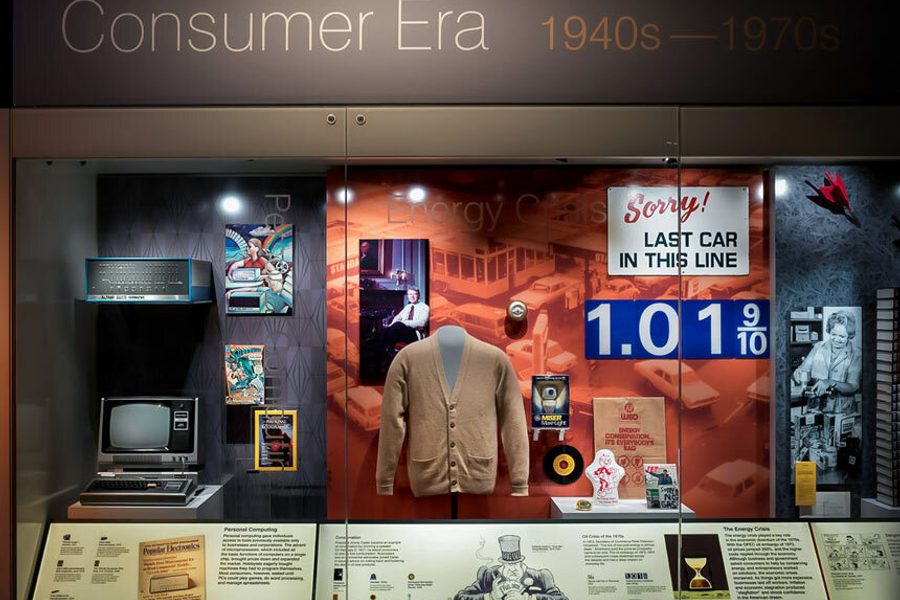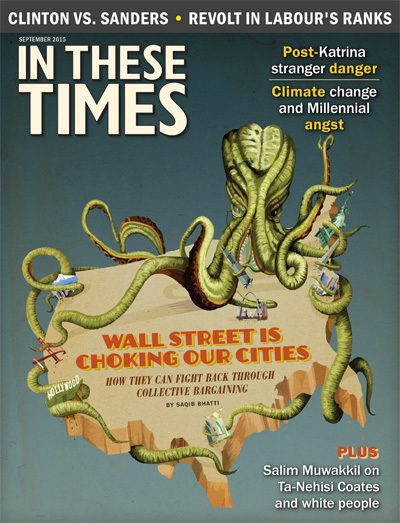Who’s Behind the Smithsonian Museum’s $63 Million Ode to American Capitalism?
Just who you would think.
Chris Lehmann

On the logo for the Smithsonian National Museum of American History’s new 45,000-squarefoot wing devoted to business history, the descriptor “America innovates” is capped with a giant exclamation point. This flourish catches the casual tourist a bit off-guard. It’s as though some hapless intern had walked into a harried marketing manager’s office to ask, sheepishly, “What is it that America does again?”
Corporate funders from Intel to Monsanto to Mars Inc. pooled their deductible foundation dosh to help underwrite this $63 million, Ken Burns-style paean to their own market-conquering genius. Hectic interactive displays about everything from the cotton gin to the iPod render America a land of manic entrepreneurial invention.
But the mandate to celebrate America business innovation clearly ran afoul of a directive to maximize multicultural inclusion, with unsettling results. One files past a predictable gee-whiz bank of displays about Silicon Valley into the impoverished Bronx ghetto of the 1970s, presented as an equally entrepreneurial wonderland. The Bronx, you see, was just “the right environment for the invention of hip-hop … the urban landscape provided the raw materials.” As if this weren’t condescending enough, a video installation features one Art Molella, the emeritus director of the Lemelson Center (the foundation bankrolling the display) cheerfully explaining that “sometimes being deprived of materials drives you to invent even more strenuously.”
This same decontextualized business boosterism dominates the main attraction, the American Enterprise exhibit in the Mars Hall of American Business. The Whiggish narrative of business triumph makes no allowance for the considerable hidden costs. Take this gnomic thumbnail for the 19th-century monopolist John Jacob Astor: “Though he never set a trap for beavers, Astor became America’s richest man by selling their fur.” Visitors wondering just how that’s supposed to work learn nothing of Astor’s sweetheart protectionist deals with Congress or his detours into drug smuggling. He was just really, really innovative, all right?
Nearby, a humble grass-woven basket bears this bizarre legend: “Jemmy, about 1825-unknown. Enslaved entrepreneur. Jemmy learned basket-weaving from his elders while enslaved in South Carolina. Most of his sweetgrass baskets were used on the plantation, but he secretly paddled the low-country waterways to take others to market.” The clear subtext is that had only poor Jemmy, whose labor value was brutally expropriated, been granted more sustained access to those inviting low-country markets — or, you know, perhaps had worked a little harder to earn it—this whole awkward slavery thing might have been productively sidestepped. Despite much attention lavished on Eli Whitney’s cotton gin, there’s no overt acknowledgment that slavery operated hand in hand with American enterprise for three centuries.
There are a few clumsy efforts to note that our nation’s enterprising history has not been without its moments of worker outrage and outright political confrontation. But over and over again, we’re reminded that solitary market geniuses come along at just the right time to make it all better. There’s Sam Walton, “Revolutionary Retailer” (not “union-busting destroyer of small competitors”), and Henry Paulson, “Recovery Agent” (not “the Goldman Sachs chairman-turned-Treasury secretary who safeguarded the bonuses of his investment-banking brethren after the financial crisis”).
Also unspecified is just who was responsible for that crisis. Cue the unfortunate misbehavior of unspecified bad apples: “Deregulation in the financial sector opened new opportunity to many, but by the early 2000s some lenders became greedy and ignored risk. Government regulators also became lax.” Certainly it had nothing to do with an industry-captured regulatory state that stretched back to the Carter years.
The only thing in this saga that doesn’t operate in a free-floating state of causelessness is the methodology of the exhibit itself. Over at “The Consumer Era (1940−1970),” visitors encounter this approvingly worded notation: “Cold War business magazines and propaganda illustrated the benefits of capitalism to American consumers and tied consumerism to democratic values.” Now that deserves an exclamation point.









